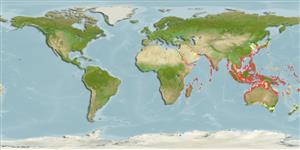Common names from other countries
Classification / Names / Names
Namen | Synonyme | Catalog of Fishes (gen., sp.) | ITIS | CoL | WoRMS
Environment: milieu / climate zone / depth range / distribution range
Ökologie
; tiefenbereich 0 - 40 m (Ref. 349). Tropical
Indo-West Pacific: from East Africa, to Melanesia; north to Japan, and south to northern Queensland and New Caledonia. Apparently rare in Australia.
Length at first maturity / Size / Gewicht / Alter
Maturity: Lm ? range ? - ? cm Max length : 28.0 cm SHL Männchen/unbestimmt; (Ref. 349); common length : 20.0 cm SHL Männchen/unbestimmt; (Ref. 349)
Collected for food and for the large, heavy shell in many areas. Mature shell is traditionally used as a trumpet when the tip of the spire is cut off (Ref. 349). Common on inner reef flats and in shallow water near rocky areas, but frequent also offshore. Occurs at the low tide mark. Fasciolariidae are active predators, feeding on tube worms, vermetid and other molluscs (Ref. 349).
Life cycle and mating behavior
Geschlechtsreife | Fortpflanzung | Ablaichen | Eier | Fecundity | Larven
This species is a non-broadcast spawner. Life cycle does not include trocophore stage. Also Ref. 833.
Poutiers, J.M. 1998. (Ref. 349)
IUCN Rote Liste Status (Ref. 130435)
CITES Status (Ref. 108899)
Not Evaluated
Not Evaluated
Bedrohung für Menschen
Harmless
Nutzung durch Menschen
Fischereien: kommerziell
| FishSource |
Tools
Mehr Information
Alter/GrößeWachstumLänge-GewichtLänge-LängeMorphologieLarvenDichte
Internet Quellen
Estimates based on models
Preferred temperature
(Ref.
115969): 24.1 - 29.1, mean 28.1 (based on 1234 cells).
Verwundbarkeit
Low vulnerability (18 of 100).
Preiskategorie
Unknown.
